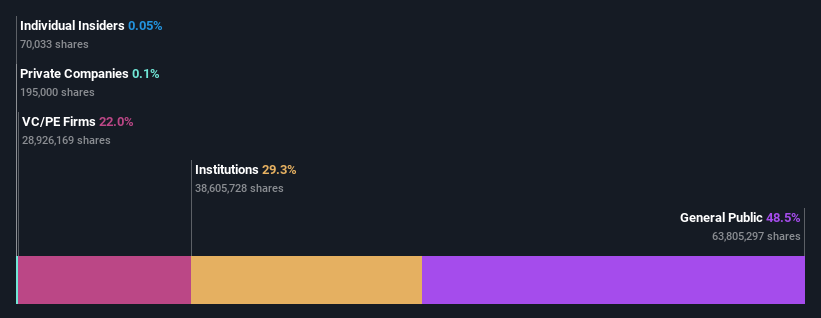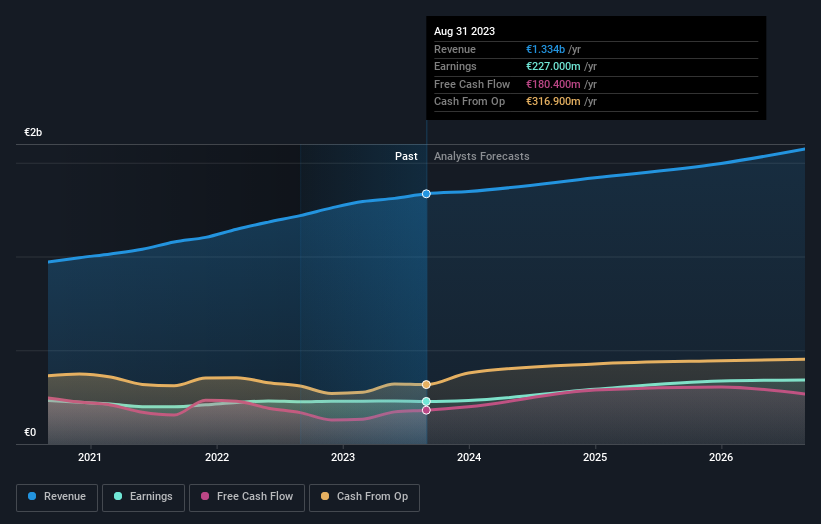Individual investors who have a significant stake must be disappointed along with institutions after Chr. Hansen Holding A/S' (CPH:CHR) market cap dropped by kr.3.1b

Key Insights
- The considerable ownership by individual investors in Chr. Hansen Holding indicates that they collectively have a greater say in management and business strategy
- The top 25 shareholders own 44% of the company
- Institutional ownership in Chr. Hansen Holding is 29%
To get a sense of who is truly in control of Chr. Hansen Holding A/S (CPH:CHR), it is important to understand the ownership structure of the business. The group holding the most number of shares in the company, around 48% to be precise, is individual investors. Put another way, the group faces the maximum upside potential (or downside risk).
While the holdings of individual investors took a hit after last week’s 4.2% price drop, institutions with their 29% holdings also suffered.
In the chart below, we zoom in on the different ownership groups of Chr. Hansen Holding.
View our latest analysis for Chr. Hansen Holding

What Does The Institutional Ownership Tell Us About Chr. Hansen Holding?
Many institutions measure their performance against an index that approximates the local market. So they usually pay more attention to companies that are included in major indices.
As you can see, institutional investors have a fair amount of stake in Chr. Hansen Holding. This implies the analysts working for those institutions have looked at the stock and they like it. But just like anyone else, they could be wrong. When multiple institutions own a stock, there's always a risk that they are in a 'crowded trade'. When such a trade goes wrong, multiple parties may compete to sell stock fast. This risk is higher in a company without a history of growth. You can see Chr. Hansen Holding's historic earnings and revenue below, but keep in mind there's always more to the story.

We note that hedge funds don't have a meaningful investment in Chr. Hansen Holding. Novo Holdings A/S is currently the largest shareholder, with 22% of shares outstanding. With 3.0% and 2.9% of the shares outstanding respectively, Norges Bank Investment Management and The Vanguard Group, Inc. are the second and third largest shareholders.
Our studies suggest that the top 25 shareholders collectively control less than half of the company's shares, meaning that the company's shares are widely disseminated and there is no dominant shareholder.
While it makes sense to study institutional ownership data for a company, it also makes sense to study analyst sentiments to know which way the wind is blowing. There are a reasonable number of analysts covering the stock, so it might be useful to find out their aggregate view on the future.
Insider Ownership Of Chr. Hansen Holding
The definition of company insiders can be subjective and does vary between jurisdictions. Our data reflects individual insiders, capturing board members at the very least. Management ultimately answers to the board. However, it is not uncommon for managers to be executive board members, especially if they are a founder or the CEO.
I generally consider insider ownership to be a good thing. However, on some occasions it makes it more difficult for other shareholders to hold the board accountable for decisions.
Our most recent data indicates that insiders own less than 1% of Chr. Hansen Holding A/S. As it is a large company, we'd only expect insiders to own a small percentage of it. But it's worth noting that they own kr.37m worth of shares. It is always good to see at least some insider ownership, but it might be worth checking if those insiders have been selling.
General Public Ownership
The general public-- including retail investors -- own 48% stake in the company, and hence can't easily be ignored. This size of ownership, while considerable, may not be enough to change company policy if the decision is not in sync with other large shareholders.
Private Equity Ownership
With a stake of 22%, private equity firms could influence the Chr. Hansen Holding board. Some investors might be encouraged by this, since private equity are sometimes able to encourage strategies that help the market see the value in the company. Alternatively, those holders might be exiting the investment after taking it public.
Next Steps:
It's always worth thinking about the different groups who own shares in a company. But to understand Chr. Hansen Holding better, we need to consider many other factors. To that end, you should be aware of the 2 warning signs we've spotted with Chr. Hansen Holding .
Ultimately the future is most important. You can access this free report on analyst forecasts for the company.
NB: Figures in this article are calculated using data from the last twelve months, which refer to the 12-month period ending on the last date of the month the financial statement is dated. This may not be consistent with full year annual report figures.
New: AI Stock Screener & Alerts
Our new AI Stock Screener scans the market every day to uncover opportunities.
• Dividend Powerhouses (3%+ Yield)
• Undervalued Small Caps with Insider Buying
• High growth Tech and AI Companies
Or build your own from over 50 metrics.
Have feedback on this article? Concerned about the content? Get in touch with us directly. Alternatively, email editorial-team (at) simplywallst.com.
This article by Simply Wall St is general in nature. We provide commentary based on historical data and analyst forecasts only using an unbiased methodology and our articles are not intended to be financial advice. It does not constitute a recommendation to buy or sell any stock, and does not take account of your objectives, or your financial situation. We aim to bring you long-term focused analysis driven by fundamental data. Note that our analysis may not factor in the latest price-sensitive company announcements or qualitative material. Simply Wall St has no position in any stocks mentioned.
About CPSE:CHR
Chr. Hansen Holding
Chr. Hansen Holding A/S, a bioscience company, develops natural ingredient solutions for the food, nutritional, pharmaceutical, and agricultural industries in Europe, the Middle East, Africa, North America, Latin America, and the Asia Pacific.
Adequate balance sheet average dividend payer.


